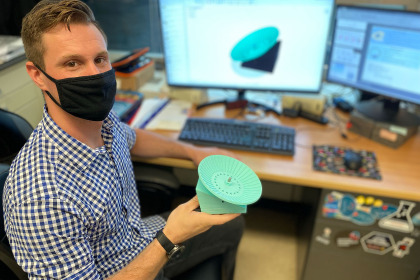Like many inventions, the LOST-Wheel was born out of necessity and, jokes Bivona, out of spite. In his final years as a Cellular, Molecular, and Biomedical Sciences graduate student, Bivona worked on a grant-funded project in the laboratory of UVM Larner College of Medicine Professor of Medicine Matthew Poynter, Ph.D. The project, says Poynter, aims to determine the contribution of skeletal muscle contractile muscle cells (myocytes) to local and systemic inflammation and the potential benefits of exercise to diminish overexuberant or protracted inflammation. The work relies heavily on the study of mouse models after they exercise either on rodent treadmills (yes, they make treadmills for rodents) or on small circular machines commonly called mouse wheels.

JJ Bivona, Ph.D., sits at a desk in his lab holding his invention - the LOST Wheel. A computer screen behind him displays a rendering of the invention.
Faint whirring and clicking noises emit from the 3D printer on the counter behind University of Vermont (UVM) postdoctoral fellow J.J. Bivona, Ph.D.’22, as it moves purposefully from side-to-side and up-and-down. The layers of molten plastic carefully deposited by the initial passes of the machine don’t look like much yet, but the computer monitor on Bivona’s desk hints at the appearance of the finished product. As Bivona moves his computer mouse, a teal object that looks like a small, plastic satellite dish spins on the screen—allowing him to see the object in multiple dimensions and from every angle. The object is a key component of Bivona’s recent invention—a 3D-printable open-source mouse wheel he calls the Lockable Open-Source Training (LOST) Wheel.
Read the full story >>